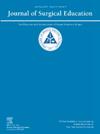Predictors of Match Success for Reapplicants in Plastic and Reconstructive Surgery: Insights From Program Directors
IF 2.1
3区 医学
Q1 EDUCATION, SCIENTIFIC DISCIPLINES
引用次数: 0
Abstract
Objective
Plastic and reconstructive surgery (PRS) is among the most competitive specialties, with up to 45% going unmatched each year. While extensive research exists on first-time PRS applicants, data on reapplicants remain limited. This study examines PRS Program Directors’ (PDs) perceptions of reapplicants, preferred pathways, and key factors influencing reapplication success.
Design
The 12-item survey included questions regarding perceived stigma toward reapplicants, recommended reapplication strategies, and barriers to matching.
Setting
Multi-institutional
Participants
The survey was distributed via email to PRS PDs through American Council of Academic Plastic Surgeons from November 2024 to February 2025.
Results
Twenty-five (28.5%) PDs completed the survey. Of these, 21 (84.0%) acknowledged stigma toward reapplicants, while 20 (80.0%) reported offering interviews at least "sometimes." PDs who recognized stigma were not significantly more likely to offer interviews than those who did not (45.5% vs. 33.3%; p = 0.593). The most favored pathways were a preliminary surgical internship (n = 17, 54%) and research fellowship (n = 11, 22%). Key factors for reapplicant success included excelling in clinical rotations (n = 11, 22.0%), conducting new research (n = 9, 18.0%), and rotating in the target department (n = 7, 14.0%). The greatest barriers were lack of resume improvement (n = 11, 22.0%), poor interview performance (n = 8, 16.0%), and weak letters of recommendation (n = 8, 16.0%).
Conclusion
While stigma exists, most PRS programs still consider reapplicants. The most recommended pathway for reapplicants was a preliminary surgical internship, followed by a research fellowship. Additionally, PDs emphasized clinical excellence, research productivity, and mentorship as key factors for success. Ultimately, reapplicants must take a critical, personalized approach to their deficiencies.
整形和重建外科再申请者匹配成功的预测因素:来自项目主管的见解。
目的:整形和重建外科(PRS)是最具竞争力的专业之一,每年有高达45%的人无法匹配。虽然对首次申请减贫计划的人进行了广泛的研究,但关于再次申请减贫计划的人的数据仍然有限。本研究探讨了PRS项目主任对再申请人、首选途径和影响再申请成功的关键因素的看法。设计:12项调查包括对重新申请的感知耻辱,推荐的重新申请策略和匹配障碍。背景:多机构参与者:该调查于2024年11月至2025年2月期间通过美国学术整形外科医生委员会通过电子邮件发送给PRS博士。结果:25名pd(28.5%)完成了调查。其中,21家(84.0%)承认对重新申请者的歧视,而20家(80.0%)表示至少“有时”会提供面试机会。认识到耻辱的pd提供采访的可能性并不比没有认识到耻辱的pd更大(45.5% vs。33.3%; = 0.593页)。最受青睐的途径是外科初步实习(n = 17,54%)和研究奖学金(n = 11,22%)。再次申请成功的关键因素包括临床轮转表现优异(n = 11,22.0%),开展新研究(n = 9,18.0%),以及在目标科室轮转(n = 7,14.0%)。最大的障碍是简历缺乏完善(n = 11,22.0%),面试表现不佳(n = 8,16.0%),推荐信不强(n = 8,16.0%)。结论:尽管存在耻辱感,但大多数PRS计划仍会考虑重新申请。对于再申请者,最推荐的途径是初步的外科实习,然后是研究奖学金。此外,pd强调临床卓越、研究效率和指导是成功的关键因素。最后,重新申请的人必须对自己的不足采取批判性的、个性化的方法。
本文章由计算机程序翻译,如有差异,请以英文原文为准。
求助全文
约1分钟内获得全文
求助全文
来源期刊

Journal of Surgical Education
EDUCATION, SCIENTIFIC DISCIPLINES-SURGERY
CiteScore
5.60
自引率
10.30%
发文量
261
审稿时长
48 days
期刊介绍:
The Journal of Surgical Education (JSE) is dedicated to advancing the field of surgical education through original research. The journal publishes research articles in all surgical disciplines on topics relative to the education of surgical students, residents, and fellows, as well as practicing surgeons. Our readers look to JSE for timely, innovative research findings from the international surgical education community. As the official journal of the Association of Program Directors in Surgery (APDS), JSE publishes the proceedings of the annual APDS meeting held during Surgery Education Week.
 求助内容:
求助内容: 应助结果提醒方式:
应助结果提醒方式:


